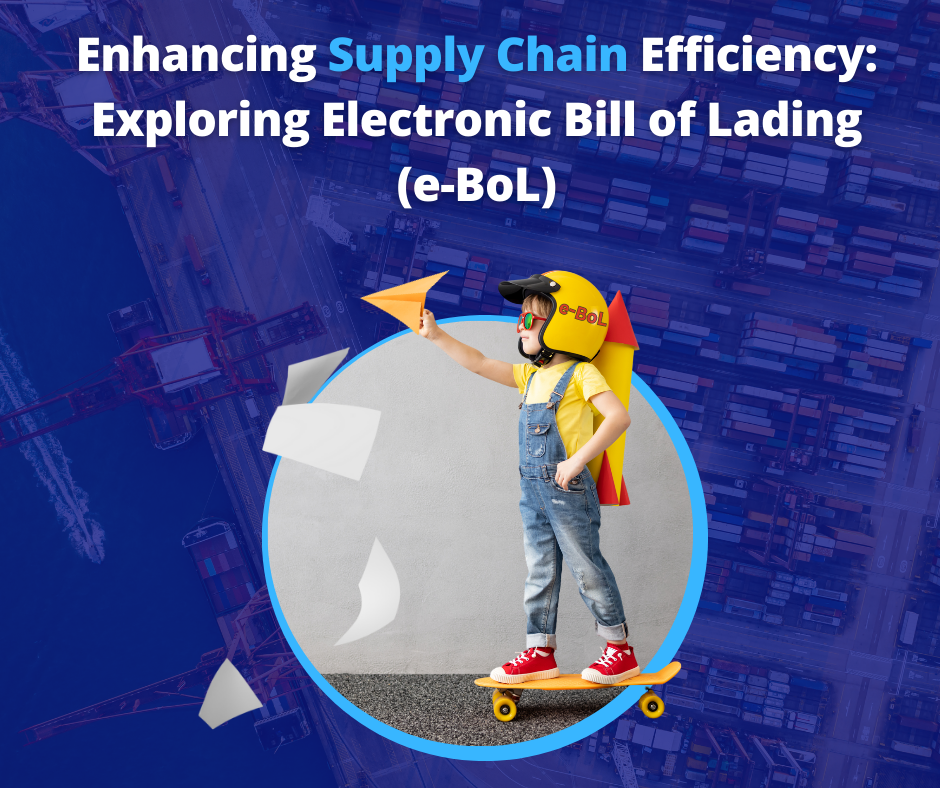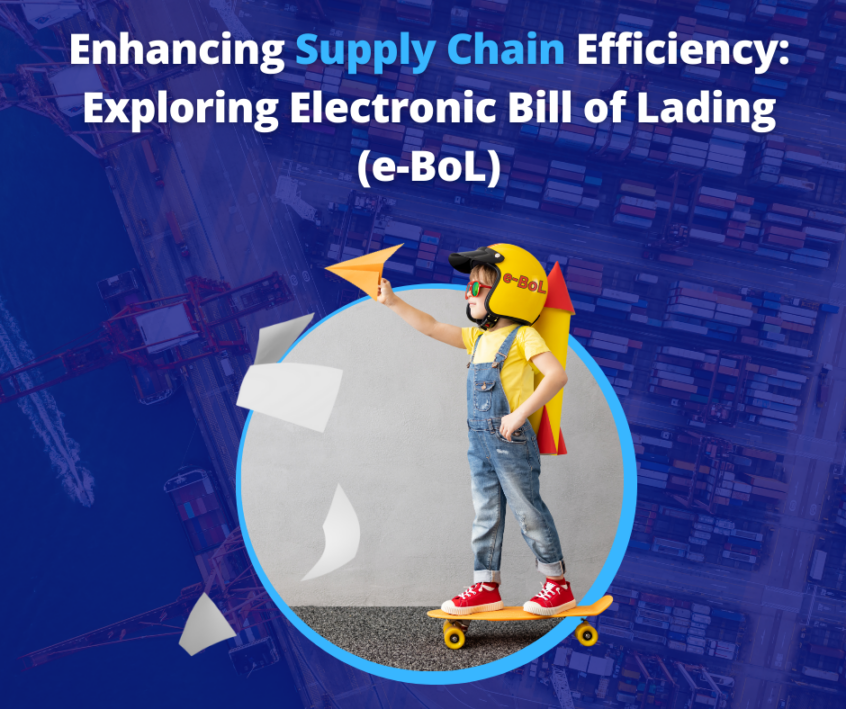
Everything you need to know
One of the most important documents in the shipping process is the electronic bill of lading (e-BoL) because it is essential for ensuring the safety of cargo during transit. The e-BoL, a critical security measure, is a formal record of the shipment. Hence, it will include the latest details about the transporter, recipient, and shipper. It is important to note that e-BoL is the digital version of the old style Bill of Lading or BOL, emphasizing the critical role it plays in facilitating the process of transporting and delivering cargo.
Key aspects of the electronic bill of lading
This article explores the meaning and uses of e-BoLs. For instance, it explains why an electronic bill of lading is vital for operations. Moreover, the article will describe some of the advantages of the electronic bill of lading. As an e-BoL serves as a legal document issued by a carrier to a shipper for the transportation of goods, it contains essential information about the cargo, including the type, quantity, and destination, as well as the terms and conditions of transportation.
The e-BoL’s purpose is to facilitate the exchange, storage, and management of shipping documents more efficiently and securely through electronic means, eliminating the requirement for physical documentation while still maintaining its legal validity and reliability. Adopting an e-BoL can significantly reduce the time and costs associated with shipping processes, streamline supply chain operations, and minimize the risk of errors or fraud.
Functions of the e-BoL
An e-BoL serves several functions in transporting goods, thereby enhancing efficiency and security within the supply chain. Some of the key functions of an e-BoL include the following:
1. Evidence of contract of carriage: The e-BoL serves as a legally binding document between the shipper and the carrier, outlining the terms and conditions of transportation, responsibilities, and liabilities involved.
2. Receipt of goods: The e-BoL is proof that the carrier has received the specified goods from the shipper in the agreed-upon condition and quantity and is committed to transporting and delivering them to the designated recipient or consignee.
3. Document of title: The e-BoL enables the transfer of ownership rights of the goods during transit. By electronically endorsing or transferring the e-BoL, the current owner of the goods can sell, assign, or transfer their rights to another party without requiring the physical exchange of documents.
4. Increased security and risk mitigation: By using digital encryption and secure access controls, the e-BoL minimizes the risk of errors, fraud, and unauthorized alterations or tampering of documentation, ensuring the accuracy and legitimacy of the information contained within the document.
5. Expedited document processing: The e-BoL enables faster sharing and processing of shipping documentation among relevant parties, such as carriers, shippers, consignees, and regulatory authorities. This can significantly reduce the time and costs of traditional paper-based processes, such as courier services or manual document handling.
6. Streamlined supply chain operations: Digitizing the bill of lading process provides better transparency, real-time tracking, and improved organization of shipping documentation. This, in turn, can lead to more efficient collaboration among various stakeholders in the supply chain and contribute to optimized logistics operations.
It is essential to understand how businesses can create this tool, having explored the functions of an electronic bill of lading.
The process of creating an e-BoL
- Creating an e-BoL begins with the shipper providing all necessary information to the carrier.
- The carrier then verifies and validates this data before creating a digital document that can be used as an e-BoL.
- Once created, the e-BoL is sent to both parties for review and approval.
- After approval by both parties, the e-BoL is stored in a secure database where it can be accessed at any time.
- Finally, when goods are delivered or picked up, the relevant documents must be signed off electronically to complete the process.
In addition to understanding the procedures of creating an electronic bill of lading, businesses must be aware of how this tool can save them money.
How the e-BoL can save you money
There are several ways you will save money when using an electronic bill of lading:
- Reduced paperwork and administrative costs associated with traditional bill-of-lading processes
- Elimination of manual data entry, resulting in fewer errors and improved accuracy
- Faster processing times due to automated document exchange between parties involved in the transaction
- Improved visibility into shipment status throughout the entire supply chain process
- Ability to track shipments from origin to destination more efficiently
- Real-time updates on changes or delays that can help reduce costly disruptions
To make all these savings, following the right security protocols for the electronic bill of lading is essential.
An overview of security protocols for an e-BoL
An e-BoL is a digital document that serves as proof of the transfer of goods from one party to another. It is crucial for companies to implement appropriate security protocols to ensure the security and integrity of an e-BoL. These can include:
1. Encryption: All data associated with an e-BoL should be encrypted using secure algorithms such as AES-256 or RSA-2048 in order to protect against unauthorized access.
2. Digital signatures: A digital signature should be used to authenticate each transaction and verify its originator’s identity. This helps prevent fraud and ensures that only authorized parties have access to the information contained within an e-BoL.
3. Access control measures: Companies should also implement access control measures such as user authentication, role-based authorization, and two factor authentication in order to limit who has access to sensitive information related to an e-BoL transaction.
4. Auditing and logging: It is also important for companies to audit their systems regularly to track any suspicious activity related to their e-BoLs transactions, helping them detect potential threats quickly and take any necessary corrective action.
Apart from these controls, there are industry regulations and standards for e-BoLs that businesses should be aware of.
Industry regulations and standards for e-BoLs
Using e-BoLs is becoming increasingly popular in the shipping industry. As such, there are a number of regulations and standards that have been implemented to ensure the safe and secure transfer of e-BoLs between parties. These include:
1. International Maritime Organization’s Electronic Bills Of Lading Code (IMO e-BoL). This code sets guidelines for how e-BoLs should be created, stored, transferred, and used by all parties involved in international trade transactions.
2. The United Nations Convention on Contracts for the International Carriage of Goods Wholly or Partly By Sea (UNCITRAL Model Law on Electronic Transferable Records). This convention provides legal certainty regarding the enforceability and validity of e-BoLs under applicable law.
3. ISO 15000-5 Standard For Electronic Data Interchange In Shipping And Logistics Management Systems (EDIFACT EDI Standards). This standard defines an agreed set of rules for exchanging data electronically between trading partners within logistics management systems such as supply chain management software applications.
4. GS1 Global Trade Item Number System (GTIN). GTIN is a globally accepted system that assigns unique identifiers to products traded internationally so to be tracked throughout their lifecycle from production to delivery at the destination port/warehouse and similar points.
Wrapping up
An electronic bill of lading (e-BoL) is an important document that serves as a receipt for shipped goods. It provides proof of ownership and delivery, which helps to protect both the shipper and receiver from any potential disputes or misunderstandings. An e-BoL also allows for faster processing times since it can be sent electronically rather than through traditional paper methods.
Additionally, an e-BoL eliminates manual data entry errors by automatically populating fields with accurate information, such as weight, quantity, description, etc. This has the effect of making it easier to track shipments in real time. Finally, using an e-BoL reduces costs associated with printing and mailing physical documents while improving overall efficiency within the supply chain process.




